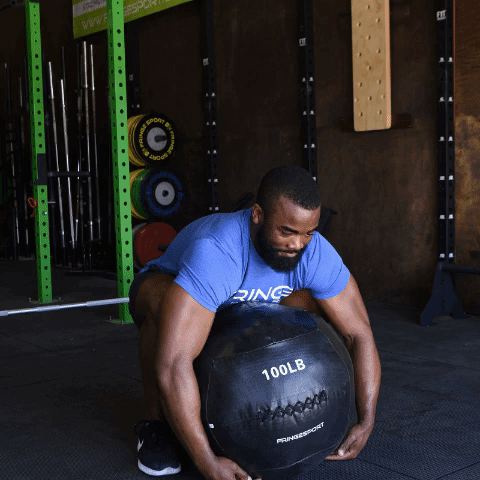Walk into a gym nowadays and you’re liable to see a near dizzying array of assorted balls to workout with. Swiss balls, wall balls, slam balls, medicine balls, Bosu balls (though they’re only half a ball) and if you’re in a gym that caters to strongmen and strongwomen, you’ll see Atlas stones.
Want to end the confusion, look confident and know what you’re doing in the gym when it’s time to put the balls to the wall? Interested in heavy ball lifting? Read on.
On the general fitness end of the ball spectrum, you have the Swiss ball and Bosu ball. Closer to the center resides the wall ball. To the right of the wall ball, you have the medicine ball, slam ball and Atlas stone. What’s the difference between the 3?
- Medicine Ball
Of the 3 balls mentioned above, you’ll probably do the lightest lifts with a medicine ball, with an exception or 2. Med balls most of the time will be somewhat soft, smooth, evenly weighted and have a little bounce. They’re not designed to be thrown against a hard surface, and thus are less durable. Med balls often are made out of rubber, leather or plastic and can be tricky to catch with sweaty hands.
Med balls are best when used as a free weight replacement during exercises and prove to be great for partner passing training (think partner sit ups or standing twists). Solo exercises that work well with the med ball include pushups, wall tosses and diagonal chops.

The softer medicine ball, with a larger diameter can weigh anything from 2 pounds to 50 pounds, with super heavy medicine balls weighing 100 pounds. Although med balls don’t handle hard impacts well (think slams) the heaviest ones can be employed as a good substitute for an Atlas stone.
- Slam Ball
Of all exercise balls, the slam ball is the most durable and heavy duty, save for the Atlas stone. The slam ball’s tough, rubber shell makes it super resilient and able to withstand unending ground impacts. Slam balls can range in weight from 15 lb to 150 lb, tend to be smaller in diameter than medicine balls and sometimes can be mushy in comparison.

The softer, solid composition of the slam ball enables the ball to be slammed against the ground with little to no rebound. This feature makes the overhead ball slam the most popular exercise to do with a slam ball. The ball slam exercise hits a bunch of different muscle groups including your abs, arms, back, glutes, calves, and quads.
Slam balls provide dynamic strength benefits as well as cardio fitness elements into your training. Although you can use slam balls to sub for free weights in some exercises like squats, sit ups, et. al., their true purpose lies in throwing exercises.
The compact slam ball, with its harder shell, lives to be thrown anywhere, whether outside, inside, at the gym or in the park. Better yet, since it doesn’t bounce up and hit you in the face, you can throw it as hard as you possibly can.
- Atlas Stone
The Atlas Stones first appeared in 1986, the stones are 5 round, concrete stones that increase in weight from 100 to 160 kg. Each stone must be placed on a series of 5 high platforms that line up next to each other. At first, it was rare for each stone to be lifted. Now, all are expected to be lifted, each competitor is timed and the shortest time to lift all 5 stones wins.
I like stacking up a couple of plyos and lifting the 100 lb med ball on top, strongman style, mimicking an Atlas stone. The larger diameter makes it more realistic and awkward than using a slam ball. It’s also not as squishy. The plyos stack up to just over 4 feet, so it’s a fun, poor man’s Atlas stone workout. Do 4 or 5 of these in a row and you start feeling it fast.

Why Exercise Balls Improve Workouts
Whether using Atlas Stones, a med ball or slam ball, each one improves your functional fitness, strength, hand-eye coordination, as well as cardio health and explosive power.
- Wall balls and Atlas stones require explosive movements and thrusting movements that provide quick, noticeable increases in power.
- Wall balls, med balls and Atlas Stones are all great for dynamic exercises that hit multiple muscle groups, force them to work together, building overall strength.
- Do 4 or 5 Atlas Stone lifts followed by some slam ball over-the-shoulder throws and you’ll be feeling your heart pumping HARD. The demands on your heart and lungs work wonders for cardio health.
- All 3 balls boost your functional fitness, meaning they improve your everyday strength to bend down, squat, and/or pick up things, as opposed to single movements or isolate muscle exercises.
- You don’t ever want to take a ball to the face, especially an Atlas Stone. Working with heavy balls obliges you to stay on your toes, literally and figuratively, helping you to refine your hand-eye coordination.

If you’re seriously considering strongman training and using Atlas Stones, read this article here for more about the benefits and/or this article to learn more about the specific muscles employed and proper technique.


